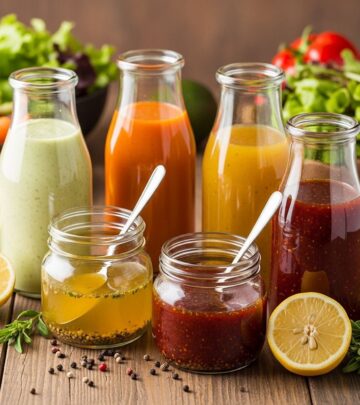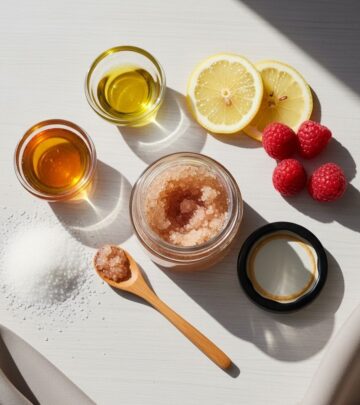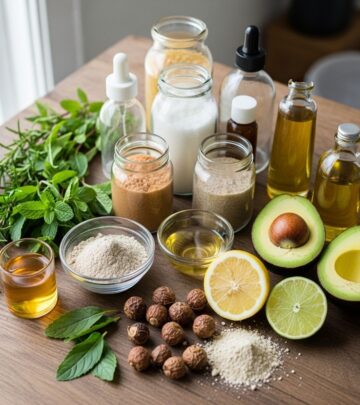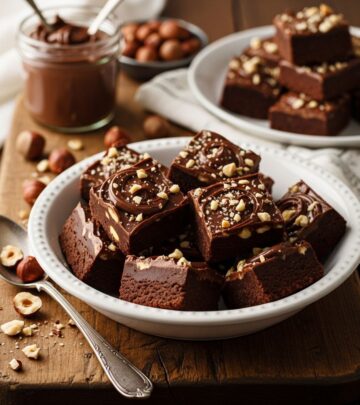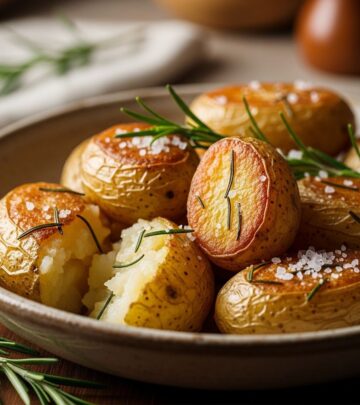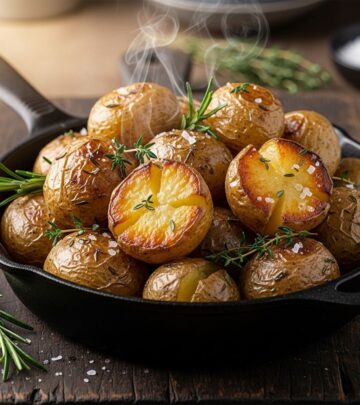Homemade Applesauce Recipe: 4-Ingredient Comfort Snack
A quick and easy homemade applesauce that brings warmth and comfort to any meal
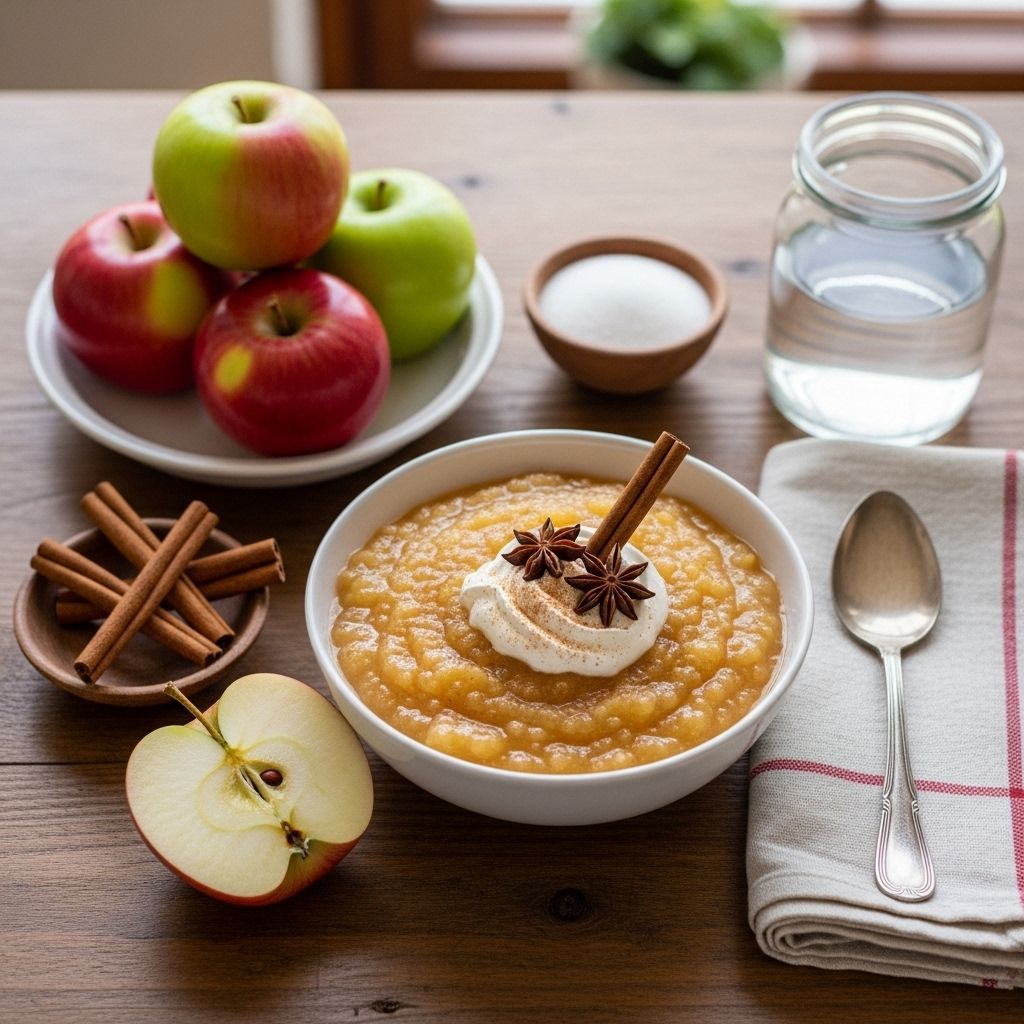
Image: HearthJunction Design Team
Sarah’s Homemade Applesauce
There’s something incredibly satisfying about making your own applesauce at home. The process fills your kitchen with the warm, comforting aroma of cinnamon and apples, creating an inviting atmosphere that’s hard to resist. Sarah’s Homemade Applesauce recipe has become a favorite among home cooks for its simplicity and delicious results. With just a handful of ingredients and minimal effort, you can create a versatile side dish that pairs beautifully with a wide range of meals or stands alone as a wholesome snack.
Whether you’re looking to use up an abundance of apples from your latest orchard visit or simply craving a homemade treat that brings comfort and warmth, this applesauce recipe delivers exceptional flavor with minimal fuss. The beauty of making applesauce from scratch is that you control everything from the sweetness level to the texture, allowing you to customize it perfectly to your preferences.
Why Make Homemade Applesauce?
Store-bought applesauce certainly has its place, but the homemade version offers numerous advantages that make it worth the small amount of effort required. When you make applesauce at home, you eliminate unnecessary preservatives and can adjust the sugar content to suit your dietary needs. Plus, the flavor of freshly made applesauce is incomparably richer and more complex than what you’ll find in commercial varieties.
Making your own applesauce also allows you to experiment with different apple varieties, creating unique flavor profiles that showcase the distinct characteristics of each type. Whether you prefer the tartness of Granny Smith apples or the natural sweetness of Honeycrisp, your homemade applesauce will reflect those preferences in ways that mass-produced versions simply cannot.
Ingredients Overview
One of the most appealing aspects of Sarah’s Homemade Applesauce is its short, simple ingredient list. You’ll need just four basic components to create this delicious treat:
- 4 apples – peeled, cored, and chopped
- ¾ cup water
- ¼ cup white sugar
- ½ teaspoon ground cinnamon
Choosing the Right Apples
While this recipe works with virtually any apple variety, certain types will yield different flavor profiles and textures. For a balanced applesauce with the perfect blend of sweetness and tartness, consider using a mix of different apple varieties. Some excellent options include:
- McIntosh: These apples break down easily during cooking, creating a smooth texture.
- Honeycrisp: Known for their natural sweetness and crisp texture, they add wonderful flavor.
- Granny Smith: Their tartness provides a nice counterpoint to the added sugar.
- Golden Delicious: These offer a mild, sweet flavor that works well in applesauce.
- Fuji: Sweet and firm, these apples hold up well during cooking while adding natural sweetness.
The beauty of homemade applesauce is that you can experiment with different combinations until you find your perfect blend. Consider the season and what’s available locally for the freshest options.
Step-by-Step Instructions
Creating Sarah’s Homemade Applesauce couldn’t be simpler. Follow these straightforward steps for delicious results every time:
Preparation
- Begin by washing all apples thoroughly under cool running water.
- Peel the apples using a vegetable peeler or paring knife.
- Core each apple to remove the seeds and tough center.
- Chop the apples into roughly 1-inch pieces. Don’t worry about making them perfectly uniform, as they’ll cook down.
- Measure out your water, sugar, and cinnamon so they’re ready to add to the pot.
Cooking Process
- In a medium saucepan, combine the chopped apples, water, sugar, and cinnamon.
- Stir gently to distribute the ingredients evenly.
- Cover the saucepan with a lid.
- Place over medium heat and bring to a gentle simmer.
- Cook for 15-20 minutes, stirring occasionally, until the apples are completely soft and easily pierced with a fork.
- Remove the saucepan from heat once the apples have reached the desired softness.
Finishing Touches
- Allow the apple mixture to cool slightly for easier handling.
- Using a fork or potato masher, mash the cooked apples to your preferred consistency. For a smoother applesauce, mash thoroughly; for a chunkier texture, use a lighter touch.
- Taste the applesauce and adjust sweetness or cinnamon if needed.
- Let the applesauce cool completely before transferring to storage containers.
Customization Options
While Sarah’s classic recipe provides a perfect foundation, one of the joys of homemade applesauce is how easily it can be customized to suit different preferences and dietary needs. Here are some popular variations to consider:
Sweetener Alternatives
If you’re looking to reduce refined sugar or simply experiment with different flavors, try these alternatives:
- Brown Sugar: Substitute equal amounts of brown sugar for white sugar to add a deeper, molasses-like flavor.
- Honey: Use 3 tablespoons of honey in place of the ¼ cup white sugar for a more natural sweetener.
- Maple Syrup: 3 tablespoons of pure maple syrup creates a rich, autumnal flavor profile.
- No Added Sugar: For a naturally sweet option, omit the sugar entirely and use naturally sweet apple varieties like Fuji or Honeycrisp.
Spice Variations
While cinnamon is the classic spice paired with apples, don’t be afraid to experiment with these additions:
- Nutmeg: Add a pinch (⅛ teaspoon) for a warm, nutty undertone.
- Cloves: A small amount (⅛ teaspoon) adds depth and complexity.
- Allspice: ¼ teaspoon creates a well-rounded, warm flavor.
- Vanilla Extract: Add ½ teaspoon after cooking for a sweet, aromatic note.
- Lemon Zest: ½ teaspoon brightens the flavors and adds a subtle citrus note.
Texture Options
The consistency of your applesauce is entirely up to your preference:
- Ultra-Smooth: For baby food or a completely smooth texture, process the cooked apples in a blender or food processor.
- Medium Texture: Use a potato masher for a traditional consistency with some small chunks.
- Chunky Style: Lightly mash with a fork, leaving larger pieces of apple for a more rustic applesauce.
Serving Suggestions
Homemade applesauce is incredibly versatile and can be enjoyed in numerous ways beyond simply eating it by the spoonful (though that’s certainly delicious too!). Here are some popular serving ideas:
As a Side Dish
Applesauce pairs wonderfully with many main courses, including:
- Roasted pork loin or pork chops
- Grilled or baked chicken
- Traditional potato latkes
- German sausages or bratwurst
- Holiday ham or turkey
Breakfast Applications
Start your day with the sweet comfort of applesauce:
- Stirred into oatmeal or porridge
- Topped with granola and yogurt for a parfait
- Spread on toast with a sprinkle of cinnamon
- Mixed into pancake or waffle batter
- Served alongside French toast
Baking Ingredient
Applesauce makes an excellent addition to many baked goods:
- As an oil or butter substitute in muffins and quick breads
- Mixed into cake batters for moisture and flavor
- Layered in parfaits or trifles
- As filling for turnovers or hand pies
- Swirled into cheesecake batter before baking
Storage and Preservation
One of the advantages of making your own applesauce is being able to prepare larger batches for future enjoyment. Here’s how to properly store your homemade creation:
Refrigerator Storage
For short-term storage:
- Allow the applesauce to cool completely before refrigerating.
- Transfer to airtight containers, leaving about ½ inch of headspace.
- Store in the refrigerator for up to 7-10 days.
- Look for any signs of spoilage before consuming if stored for more than a week.
Freezer Storage
For longer preservation:
- Cool applesauce completely.
- Portion into freezer-safe containers, leaving about 1 inch of headspace for expansion.
- Seal tightly, label with the date, and freeze.
- Frozen applesauce maintains best quality for up to 3 months but remains safe indefinitely.
- Thaw overnight in the refrigerator before using.
Canning Option
For shelf-stable storage:
- Prepare applesauce according to the recipe, ensuring it’s heated to a full boil before canning.
- Follow proper water bath canning procedures using sterilized jars.
- Process pint jars for 15 minutes (adjust for your altitude if necessary).
- Properly sealed jars can be stored in a cool, dark place for up to 1 year.
Nutrition Information
Homemade applesauce isn’t just delicious—it also offers several nutritional benefits. Here’s an approximate breakdown of what you’ll find in a ½-cup serving of Sarah’s Homemade Applesauce:
- Calories: Approximately 75-85 calories
- Carbohydrates: 20-22g
- Dietary Fiber: 2-3g
- Sugars: 15-17g (includes both natural and added sugars)
- Protein: Less than 1g
- Fat: Less than 1g
- Vitamin C: 5-8% of daily value
- Potassium: 2-4% of daily value
For those monitoring sugar intake, remember that you can easily reduce or eliminate the added sugar in this recipe, especially when using naturally sweet apple varieties.
Cook’s Tips and Tricks
To ensure your homemade applesauce turns out perfectly every time, consider these helpful insights:
- Apple Selection: If possible, use a mix of at least two different apple varieties for more complex flavor.
- Natural Pectin: Leaving the peels on during cooking and then removing them afterward (or pureeing them in) adds natural pectin for a thicker texture.
- Lemon Juice: A squeeze of fresh lemon juice (about 1 teaspoon) helps preserve the color and brightens the flavor.
- Cooking Liquid: For additional flavor, substitute apple cider for some or all of the water.
- Taste Test: Always taste before final seasoning, as the natural sweetness of apples varies greatly by variety and ripeness.
- Slow Cooker Option: For hands-off preparation, combine all ingredients in a slow cooker and cook on low for 3-4 hours until soft.
Frequently Asked Questions (FAQs)
Q: Can I make this recipe without sugar?
A: Absolutely! The sugar in this recipe is optional and can be adjusted according to your taste preferences. If using naturally sweet apple varieties like Fuji, Gala, or Honeycrisp, you may find you don’t need any added sugar at all. You can also substitute honey, maple syrup, or other natural sweeteners if desired.
Q: Do I really need to peel the apples?
A: While the recipe calls for peeled apples, leaving the peels on is a personal preference. The peels contain additional fiber and nutrients, but they will affect the texture of your finished applesauce. If you choose to leave them on, consider pureeing the cooked applesauce in a blender for a smoother consistency.
Q: How can I tell when my applesauce is done cooking?
A: The apples are done when they’re completely soft and can be easily mashed with a fork. They should offer no resistance when pierced. Depending on the variety of apple and the size of your apple pieces, this typically takes 15-20 minutes of simmering.
Q: Why did my applesauce turn brown?
A: Browning occurs due to oxidation when apples are exposed to air. To prevent this, you can add a tablespoon of lemon juice to the recipe, which acts as a natural preservative and keeps the applesauce looking fresh. The cinnamon in the recipe also helps disguise any natural browning.
Q: Can I double or triple this recipe?
A: Yes, this recipe scales up beautifully! Simply multiply all ingredients proportionally and use a larger pot. You may need to increase the cooking time slightly for larger batches, but otherwise, the process remains the same.
Sarah’s Homemade Applesauce is one of those simple recipes that demonstrates how a few quality ingredients, treated with care, can create something truly special. Whether enjoyed on its own as a snack, served alongside savory dishes, or incorporated into your favorite baked goods, this versatile applesauce is sure to become a staple in your culinary repertoire. The comforting aroma, wholesome ingredients, and customizable nature make it a perfect recipe for both novice and experienced cooks alike.
References
- https://www.allrecipes.com/recipe/51301/sarahs-applesauce/
- https://www.allrecipes.com/recipe/54346/applesauce/
- https://www.allrecipes.com/recipes/1333/side-dish/applesauce/
- https://www.munchingmongoose.co.za/recipes/sides-snacks/sarahs-homemade-apple-sauce
- https://www.pinterest.com/pin/sarahs-homemade-applesauce–3729612162999564/
Read full bio of Shinta

